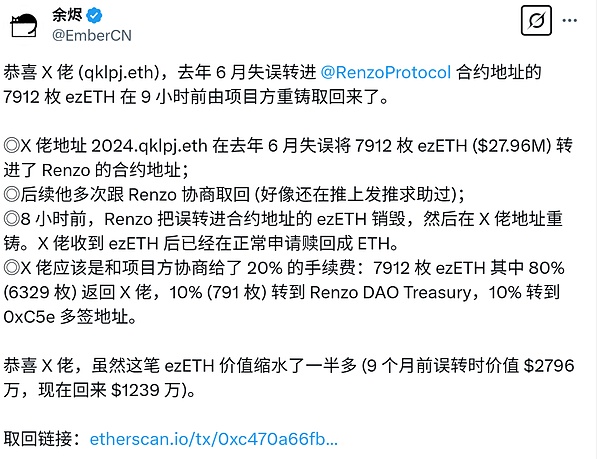
Source: Lightning HSL privacy and anonymity issues have always been the mainstream issues of cryptocurrencies and the most important issues in the industry, especially in the current situation of cryptocurrencies, almost all users of the entire cryptocurrency have to use centralized KYC-based exchanges. In addition, the United States has made legal and compliance the mainstream, and the currency circle now has a serious crisis of anonymity failure.
I saw a news today that reminded me of an EIP I had seen before. I think this is a very worthy way to promote the currency laundering method that can revolutionize the dilemma of anonymity failure of Ethereum.
This news was that half a year ago, a person accidentally transferred an asset (an erc20 token with the function of minting a new currency) to the project party's contract address. In theory, this contract address cannot be retrieved because it does not have a private key. But the project party actually re-casted an asset for that user. It is equivalent to the project party admitting that the user destroyed an asset, and then the project party issues an equal amount of assets and transfers it back to the user.
It is equivalent to if you transfer usdt to a contract address, it is impossible to withdraw this USDT. If you do not write a function on how to extract the asset in the contract in advance, but you can contact Tether and let them re-mint a USDT for you. Because Tether knows that your coin must have been destroyed, and I will give you another new one that is exactly the same, which will solve this problem.
The problem is here. If Tether directly transfers the new USDT to a brand new address, will it mix up all the historical transaction links of the original USDT?
This is a brand new way of washing coins.
There is an EIP specifically used to achieve this, EIP7503 (https://eip7503.org/).
The general principle of EIP7503 is as follows: Any address can be transferred to the black hole address (zero address, no private key, transferring to the asset is equal to destruction) into the asset X.
With this transfer transaction and the user's private key, a zero-knowledge proof document can be generated.
Then use this zero-knowledge proof document to reminisce an equal amount of asset X from a contract address implemented by EIP7503, and this new asset X can be transferred to a brand new address, which has nothing to do with the original address.
The key technical point of EIP7503 is that a contract on a chain can complete zero-knowledge verification of the destroyed transaction and mint a new equal amount of assets.
(Send a sigh, Chatgpt 4o's literary and life picture function is really TMD-awesome in terms of expressing the meaning of the text)
The current Ethereum consensus mechanism definitely does not allow the destruction of ETH, and then use the destruction transaction to reminisce ETH at a contract address.
ETH can only be minted from the block scale of the PoS consensus mechanism. This is the most core rule of Ethereum, which must not be changed.
But EIP7503 can cooperate with the erc20 asset issuer, or the erc20 asset issuer can realize the EIP7503's currency laundering function in its own tokens.
For example, usdt can add such a function. Of course, usdt will most likely not do this, otherwise its blacklisting mechanism will become invalid. I'll just give an example.
There is only one issuer for USDT now, which is the USDT contract controlled by Tether. This contract has the function of minting a new USDT coin, and the function of this coin can only be initiated by Tether.
If Tether fully believes in EIP7503, it can add a new USDT coin minting function based on the EIP7503 rule in the USDT contract, that is, transactions that destroy USDT can be used to call the new coin function through zero intelligence proof, and transfer the newly minted coin to a brand new address.
This completely eliminates the USDT historical transaction record.
This is a very thorough way to wash coins.
If EIP7503 plus the upcoming Ethereum upgrade Pectra, allowing contract payment of gas on behalf of others, then the washing coins will be more thorough.
Because just using EIP7503 to wash coins, users at least have to go to another place to get some gas fees. If the user uses the coins washed out by EIP7503, it is directly a completely new Ethereum address that does not even have gas, and then spend these coins to use the contract token gas function implemented by the upcoming Pectra, which will be more completely anonymous.
At present, this EIP7503 is not supported by the Ethereum Foundation. In the Ethereum EIP list, https://eips.ethereum.org/allEIP7503 is just a draft.
I think this thing is very important and has a long way to go.











